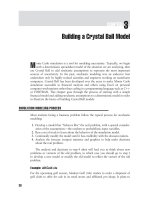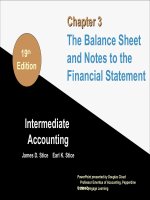Managerial decision modeling with spreadsheets by stair render chapter 03
Bạn đang xem bản rút gọn của tài liệu. Xem và tải ngay bản đầy đủ của tài liệu tại đây (208.17 KB, 52 trang )
Chapter 3:
Linear Programming
Modeling Applications
© 2007 Pearson Education
Linear Programming (LP) Can Be Used
for Many Managerial Decisions:
•
•
•
•
•
•
•
Product mix
Make-buy
Media selection
Marketing research
Portfolio selection
Shipping & transportation
Multiperiod scheduling
For a particular application we begin with
the problem scenario and data, then:
1)
2)
Define the decision variables
Formulate the LP model using the decision variables
•
•
3)
4)
Write the objective function equation
Write each of the constraint equations
Implement the model in Excel
Solve with Excel’s Solver
Product Mix Problem:
Fifth Avenue Industries
•
•
Produce 4 types of men's ties
Use 3 materials (limited resources)
Decision: How many of each type of tie to
make per month?
Objective: Maximize profit
Resource Data
Material
Silk
Yards available
Cost per yard
per month
$20
1,000
Polyester
$6
2,000
Cotton
$9
1,250
Labor cost is $0.75 per tie
Product Data
Type of Tie
Silk
Selling Price
Polyester Blend 1 Blend 2
$6.70
$3.55
$4.31
$4.81
Monthly
Minimum
6,000
10,000
13,000
6,000
Monthly
Maximum
7,000
14,000
16,000
8,500
0.125
0.08
0.10
0.10
(per tie)
Total material
(yards per tie)
Material Requirements
(yards per tie)
Type of Tie
Material
Silk
Blend 1
Polyester
(50/50)
Blend 2
(30/70)
Silk
0.125
0
0
0
Polyester
0
0.08
0.05
0.03
Cotton
0
0
0.05
0.07
0.125
0.08
0.10
0.10
Total yards
Decision Variables
S = number of silk ties to make per month
P = number of polyester ties to make per
month
B1 = number of poly-cotton blend 1 ties to
make per month
B2 = number of poly-cotton blend 2 ties to
make per month
Profit Per Tie Calculation
Profit per tie =
(Selling price) – (material cost) –(labor cost)
Silk Tie
Profit = $6.70 – (0.125 yds)($20/yd) - $0.75
= $3.45 per tie
Objective Function (in $ of profit)
Max 3.45S + 2.32P + 2.81B1 + 3.25B2
Subject to the constraints:
Material Limitations (in yards)
0.125S
< 1,000 (silk)
0.08P + 0.05B1 + 0.03B2 < 2,000 (poly)
0.05B1 + 0.07B2
< 1,250 (cotton)
Min and Max Number of Ties to Make
6,000 < S < 7,000
10,000 < P < 14,000
13,000 < B1 < 16,000
6,000 < B2 < 8,500
Finally nonnegativity S, P, B1, B2 > 0
Go to file 3-1.xls
Media Selection Problem:
Win Big Gambling Club
•
•
•
Promote gambling trips to the Bahamas
Budget: $8,000 per week for advertising
Use 4 types of advertising
Decision: How many ads of each type?
Objective: Maximize audience reached
Data
Advertising Options
Radio
Radio
TV Spot
Newspaper
(prime time)
(afternoon)
Audience
Reached
(per ad)
5,000
8,500
2,400
2,800
Cost
(per ad)
$800
$925
$290
$380
Max Ads
Per week
12
5
25
20
Other Restrictions
•
•
Have at least 5 radio spots per week
Spend no more than $1800 on radio
Decision Variables
T = number of TV spots per week
N = number of newspaper ads per week
P = number of prime time radio spots per week
A = number of afternoon radio spots per week
Objective Function
(in num. audience reached)
Max 5000T + 8500N + 2400P + 2800A
Subject to the constraints:
Budget is $8000
800T + 925N + 290P + 380A < 8000
At Least 5 Radio Spots per Week
P+A>5
No More Than $1800 per Week for Radio
290P + 380A < 1800
Max Number of Ads per Week
T < 12
P < 25
N< 5
A < 20
Finally nonnegativity
T, N, P, A > 0
Go to file 3-3.xls
Portfolio Selection:
International City Trust
Has $5 million to invest among 6 investments
Decision: How much to invest in each of 6
Objective: Maximize interest earned
investment options?
Data
Interest
Rate
Risk Score
Trade credits
7%
1.7
Corp. bonds
10%
1.2
Gold stocks
19%
3.7
Platinum stocks
12%
2.4
Mortgage securities
8%
2.0
Construction loans
14%
2.9
Investment
Constraints
•
Invest up to $ 5 million
•
No more than 25% into any one investment
•
At least 30% into precious metals
•
At least 45% into trade credits and corporate bonds
•
Limit overall risk to no more than 2.0
Decision Variables
T = $ invested in trade credit
B = $ invested in corporate bonds
G = $ invested gold stocks
P = $ invested in platinum stocks
M = $ invested in mortgage securities
C = $ invested in construction loans
Objective Function (in $ of interest earned)
Max 0.07T + 0.10B + 0.19G + 0.12P
+ 0.08M + 0.14C
Subject to the constraints:
Invest Up To $5 Million
T + B + G + P + M + C < 5,000,000
No More Than 25% Into Any One Investment
T < 0.25 (T + B + G + P + M + C)
B < 0.25 (T + B + G + P + M + C)
G < 0.25 (T + B + G + P + M + C)
P < 0.25 (T + B + G + P + M + C)
M < 0.25 (T + B + G + P + M + C)
C < 0.25 (T + B + G + P + M + C)
At Least 30% Into Precious Metals
G + P > 0.30 (T + B + G + P + M + C)
At Least 45% Into
Trade Credits And Corporate Bonds
T + B > 0.45 (T + B + G + P + M + C)
Limit Overall Risk To No More Than 2.0
Use a weighted average to calculate portfolio risk
1.7T + 1.2B + 3.7G + 2.4P + 2.0M + 2.9C < 2.0
T+B+G+P+M+C
OR
1.7T + 1.2B + 3.7G + 2.4P + 2.0M + 2.9C <
2.0 (T + B + G + P + M + C)
finally nonnegativity: T, B, G, P, M, C > 0
Go to file 3-5.xls
Labor Planning:
Hong Kong Bank
Number of tellers needed varies by time of day
Decision: How many tellers should begin work at various times of the day?
Objective: Minimize personnel cost









